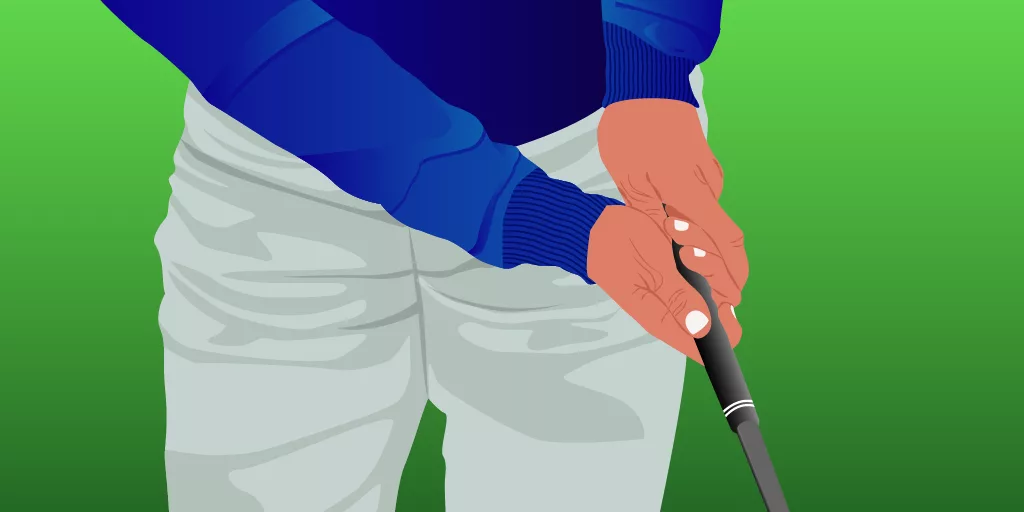
There are many different ways to grip the putter. If you spend a little time watching a professional golf event on TV, you’ll be exposed to all these various grip styles. You’ll see conventional grips, cross-handed grips, several variations of the claw grip, and other even more “creative” ones. But what you’ll also come to realize is that golfers can be effective putters using any one of these grip styles. This area of the game allows the golfer some individuality and personal preference.
Besides the actual grip style, however, there are a couple of vital underlying basics about their grip that you may not be able to see on TV. There are two underlying fundamentals that all great putters employ, regardless of which grip style they use, and you should immediately incorporate them into your putting grip as well.
In this article, we will review some of the most popular putter grip styles, but before we do that, let’s make sure that you understand these mandatory, underlying fundamentals that you simply must adopt if you want to become a better putter.
Putter Grip vs Full Swing Grip
Many amateurs make the mistake of gripping the putter in the same way that they grip their full-swing clubs. It’s important to realize that the two are, and need to be, different.
Here's why.
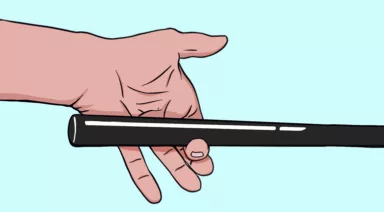
In the full swing grip, when done properly, the shaft is held in the fingers of your hands - not up in the palms - and it rests underneath the fleshy heel pad at the base of your lead hand (see photo to the right). Gripping the club this way allows you to maximize the amount of hinge (and unhinge) your wrists can create, which produces power and speed in the swing. It also allows for a lot of face rotation, which is necessary to square and release the club.
However, the results that come from gripping the shaft in that manner for the full swing are exactly what you want to avoid when putting. In putting, you don’t need power, you don’t need speed, you don’t need face rotation. What you need is control, which comes from orienting the shaft a little differently in your hands.
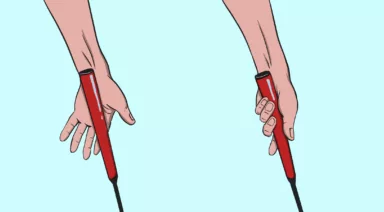
To minimize face rotation in the putting stroke, you must grip the club more in the palms of the hands, not in your fingers. The shaft should run through the palm's lifeline, and rest underneath the other fleshy pad on your hand, which is at the base of your thumb. By gripping the club in this way, the face is far less likely to rotate open and shut through the stroke and will be squarer to your target line at impact.
"One-Lever” Putting is the Key to Consistency
Another problem that results from gripping the putter too much in the fingers is that this often tends to push your hands too low at address, creating a two-lever structure. The first lever is your arms from your elbows to your hands. The second lever is from your hands to the putter head. With the hands positioned too low at address, it creates an angle between these upper and lower levers, which can introduce inconsistency. How?
With the hands too low, it tends to lift the toe of the putter up at address. When the toe is raised in this fashion, the putter face is aimed to the left of your target, necessitating a compensating swing path to start the putt on line. This two-lever structure also allows unwanted putter face rotation.
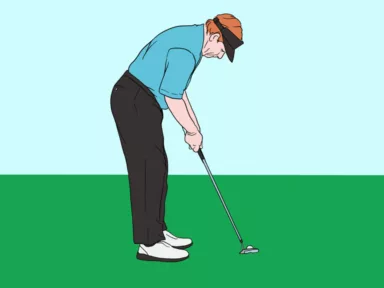
The key to avoiding this two-lever issue is to grip the putter higher in the hands (in the palms as described above), which helps to simultaneously create one single lever by raising the hands so that there is a straight line all the way from your putter head through your forearms. If you look at all the best putters in the world, you will see that almost all of them exhibit this hands-high, single-lever setup position, in which the shaft angle matches the angle of the forearms.
Grip Styles
As long as you always follow the two fundamental rules described above, the grip style you ultimately decide upon is totally up to you. With some experimentation, you’ll determine which method is the most comfortable for you, gives you the most confidence as you stand over putts, and, most importantly, performs the best.
Of the various putting grip styles that are used by golfers, the following four are the most common:
- The Conventional, Reverse Overlap Grip
- The Lead Hand Low Grip
- The Claw Grip
- The Arm Lock Grip
Let’s take a look at each of them.
The Conventional, Reverse Overlap Grip
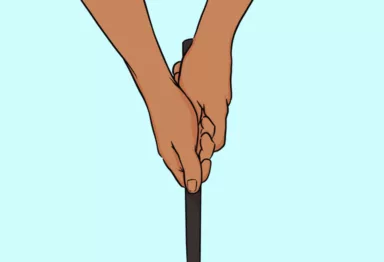
For many years the Conventional grip style has been the most prevalent one used by golfers. Essentially, the Conventional grip places the right hand below the left hand (for right-handed putters), with the two thumbs aligned one over the other down the shaft. It’s described as “reverse overlap” because the index finger of the left hand is placed over the bottom fingers of the right hand. This is the exact opposite of how the fingers are positioned in your full swing grip (hence the name Reverse Overlap). In the full swing overlapping grip, the right pinky finger is placed over the left index finger.
Although many golfers will find this grip the most natural and comfortable one, it does tend to work better with golfers who have a little natural arc to their putting stroke. Accordingly, a putter head that tends to open and close during the stroke (i.e., one with a little “toe hang”) would be the perfect complement to this grip style.
As the most common of the grip styles, dozens of pros employ it. Some of the bigger-name current Tour pros who use the Conventional grip are Dustin Johnson, Tiger Woods, Rory McIlroy, and Jon Rahm.
Lead Hand Low (AKA called Cross-Handed)
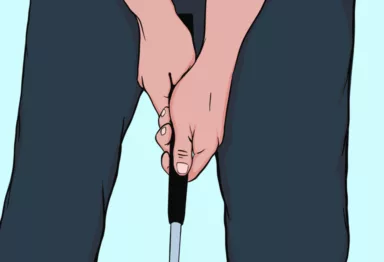
As its name suggests, this grip style reverses the position of the hands on the club, with the left hand placed below the right hand. As with the Conventional grip, both thumbs should be oriented on the top of the shaft.
Many golfers opt for the Lead Hand Low style because this positioning of the hands tends to force the shoulders to be more level. This contrasts to the Conventional grip, where some may feel that the lower right hand produces a corresponding lower right shoulder.
This grip style often favors those with a straight-back-straight-through stroke, in which the amount of face rotation is minimized. Consequently, those with this type of stroke path, and who opt for the Lead Hand Low style, may do better if they select a “face-balanced” putter. Face-balanced putters tend to limit natural face rotation, so they would match well to this type of grip and swing path.
Some popular players who use the Lead Hand Low grip are Jordan Spieth, Xander Schauffele, Billy Horschel, and Webb Simpson.
The Claw Grip
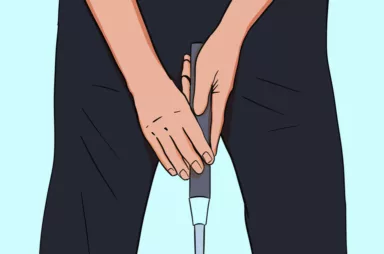
One of the most common putting stroke flaws is an over-active right hand. A right hand that becomes too dominant in the stroke can result in a lot of inconsistency in direction, the most frequent result being a putt pulled to the left. It seems that golfers have always been plagued with this issue and have sought ways to limit the control the right hand seemingly wants to assert.
It was for this exact reason that the Claw Grip was invented. Because of how the right hand is placed on the club in this grip style, its influence in the stroke is lessened, and the putter face can therefore remain squarer to the intended line.
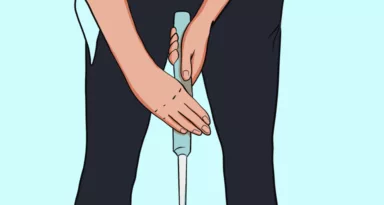
There are many variations to the Claw Grip, as golfers have experimented with numerous ways to position the right hand. But regardless of the variation, all of them have a single purpose: minimizing the effect that the right hand has in the stroke.
Some of the PGA pros who use a version of the Claw Grip are Colin Morikawa, Phil Mickelson, Sergio Garcia, Adam Scott, and Tommy Fleetwood.
The Arm Lock
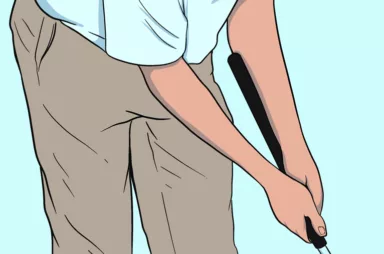
In the Arm Lock grip, the putter shaft is placed along the left forearm, stabilizing it so the golfer can maintain better control of the clubface. Because the shaft is intended to be in close contact with the lead forearm, users of this grip style often add length to their putter, allowing them to run the shaft up to their forearm without having to bend over uncomfortably to accommodate a standard-length putter. The Arm Lock style ensures that the bigger muscles control the stroke, rather than the potentially more “twitchy” smaller muscles.
Some of the PGA pros that use the Arm Lock method are Bryson DeChambeau, Matt Kuchar, and Keegan Bradley.
Final Thoughts
When it comes to gripping a putter, the most important thing is finding the style that feels the best to you and allows you to sink more putts. The pros use various grip styles and still manage to be effective putters. However, regardless of the style you choose, adopting proper putting grip fundamentals is essential to gaining consistency. This includes gripping the putter higher up in the palm of the hands and aligning the putter shaft with your forearms to create a single lever. By mastering these fundamentals, whether you prefer a conventional grip, a cross-handed grip, the claw grip, or the arm lock, you'll be on your way to better performance on the greens.